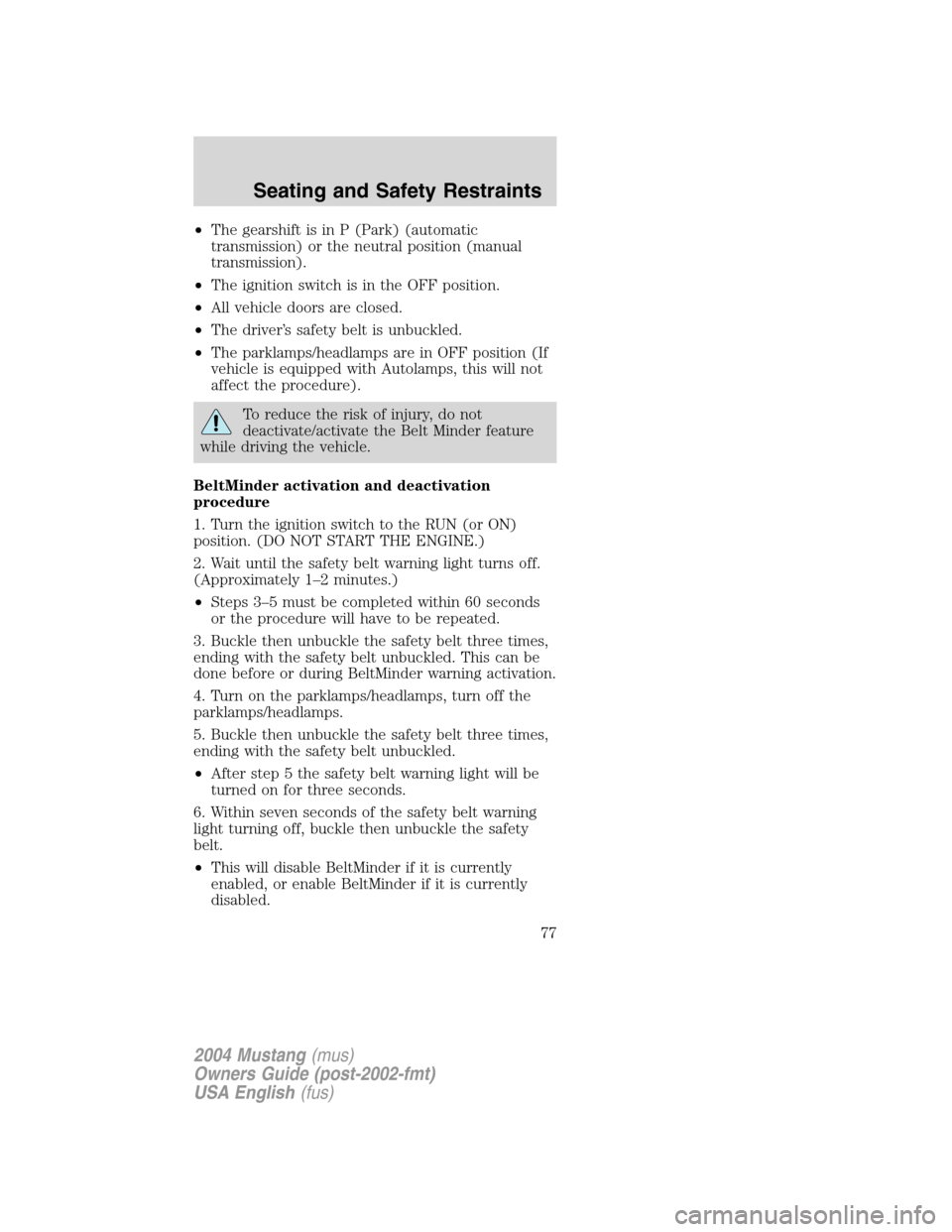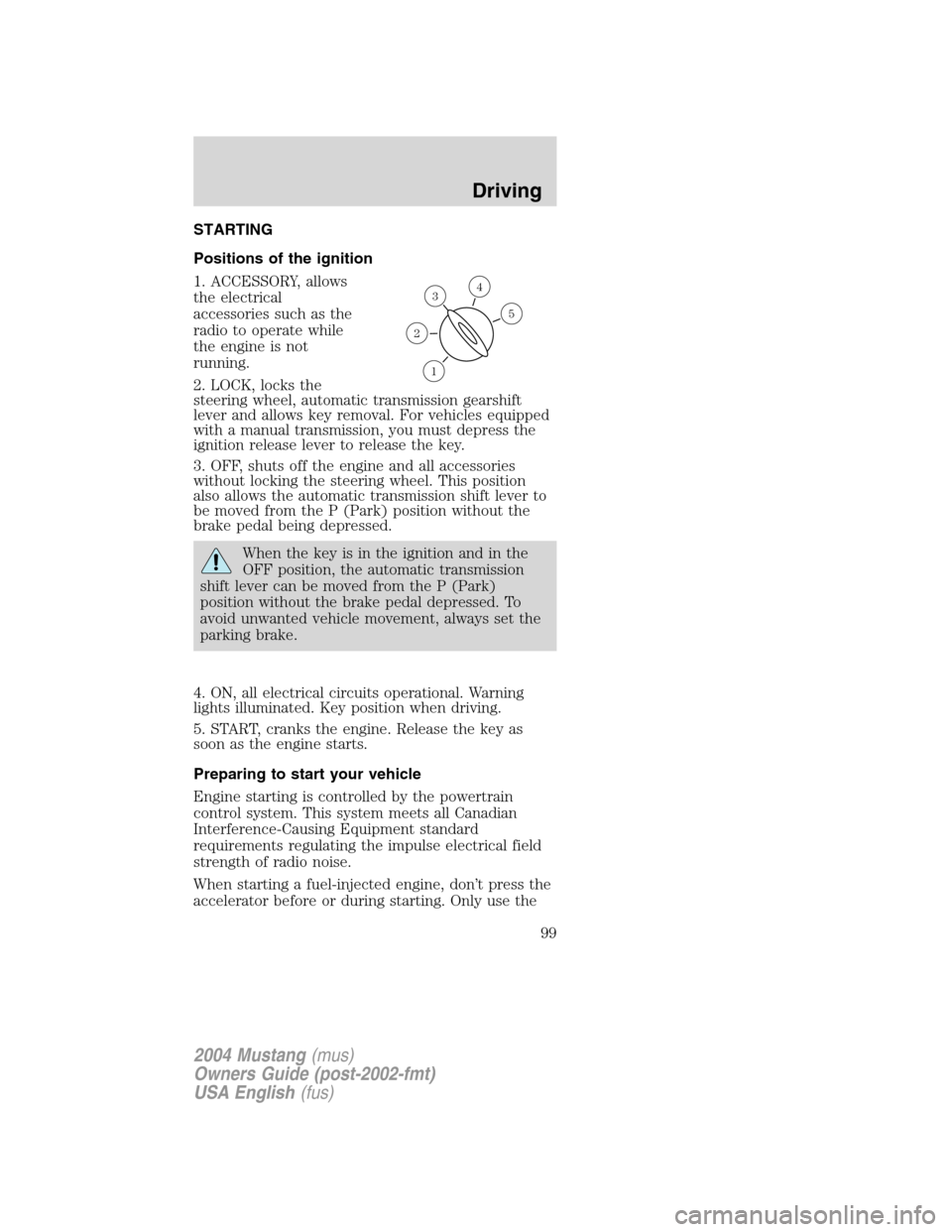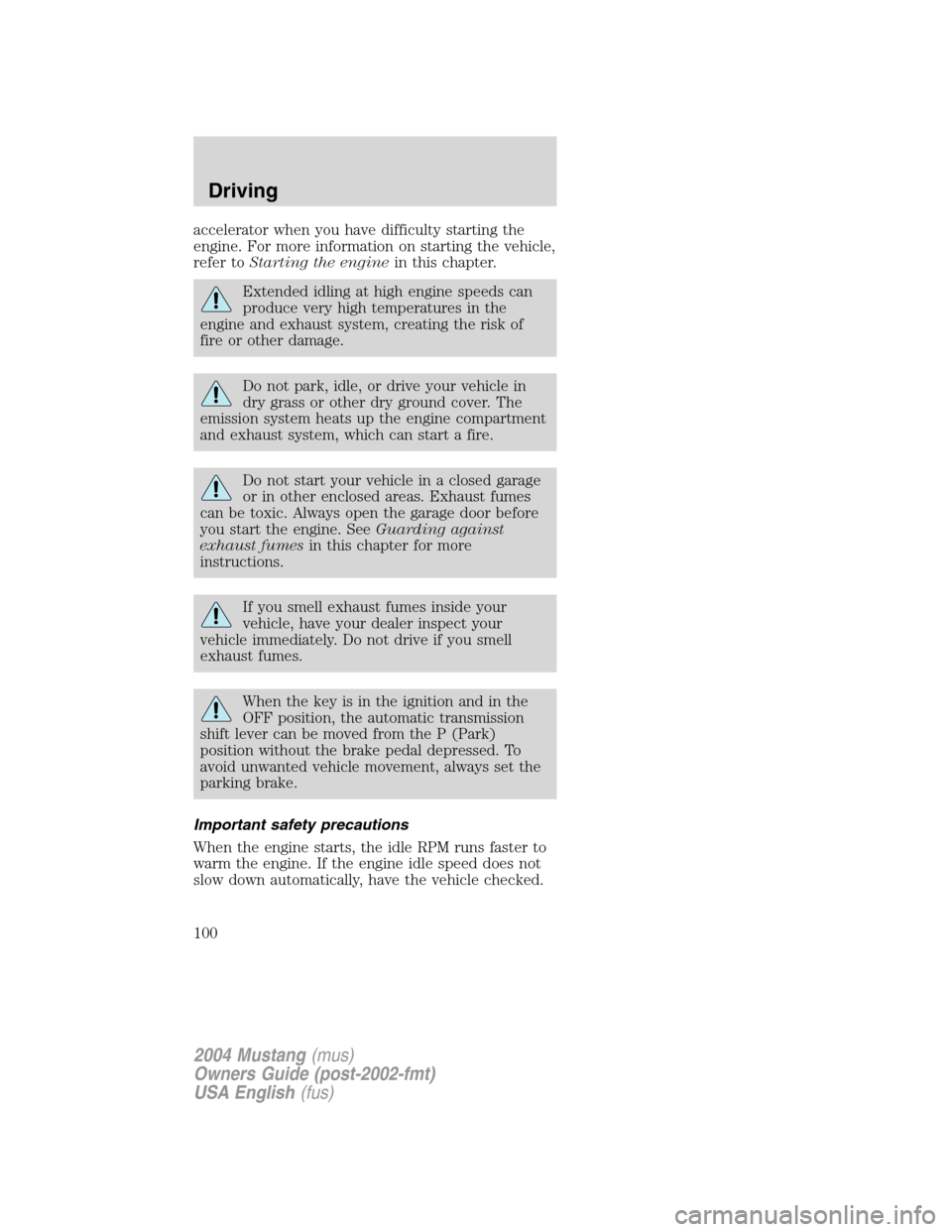Page 2 of 240
Seating and Safety Restraints 64
Seating 64
Safety restraints 68
Air bags 79
Child restraints 84
Driving 99
Starting 99
Brakes 104
Traction control 107
Transmission operation 108
Vehicle loading 117
Trailer towing 120
Roadside Emergencies 122
Getting roadside assistance 122
Hazard flasher switch 124
Fuel pump shut-off switch 124
Fuses and relays 125
Changing tires 130
Jump starting 136
Wrecker towing 141
Customer Assistance 142
Reporting safety defects (U.S. only) 152
Cleaning 153
Maintenance and Specifications 161
Engine compartment 164
Engine oil 167
Battery 171
Fuel information 182
Part numbers 215
Refill capacities 215
Lubricant specifications 218
2004 Mustang(mus)
Owners Guide (post-2002-fmt)
USA English(fus)
Table of Contents
2
Page 13 of 240

Overdrive off:
Illuminates when the
overdrive function of
the transmission has been turned off, refer to the
Drivingchapter. If the light flashes steadily or does
not illuminate, have the transmission serviced soon,
or damage may occur.
Traction Control�
active:Illuminates
when the Traction
Control�system is
active. If the light
remains on, have the system serviced immediately.
Anti-theft system:
Flashes when the
Securilock�Passive
Anti-theft System has been activated.
Turn signal:
Illuminates when the
left or right turn signal
or the hazard lights are turned on. If the indicators
stay on or flash faster, check for a burned out bulb.
High beams:
Illuminates when the
high beam headlamps
are turned on.
Key-in-ignition warning chime:Sounds when the
key is left in the ignition in the OFF/LOCK or ACC
position and the driver’s door is opened.
Headlamps on warning chime:Sounds when the
headlamps or parking lamps are on, the ignition is
off (the key is not in the ignition) and the driver’s
door is opened.O/D
OFF
2004 Mustang(mus)
Owners Guide (post-2002-fmt)
USA English(fus)
Instrument Cluster
13
Page 77 of 240

•The gearshift is in P (Park) (automatic
transmission) or the neutral position (manual
transmission).
•The ignition switch is in the OFF position.
•All vehicle doors are closed.
•The driver’s safety belt is unbuckled.
•The parklamps/headlamps are in OFF position (If
vehicle is equipped with Autolamps, this will not
affect the procedure).
To reduce the risk of injury, do not
deactivate/activate the Belt Minder feature
while driving the vehicle.
BeltMinder activation and deactivation
procedure
1. Turn the ignition switch to the RUN (or ON)
position. (DO NOT START THE ENGINE.)
2. Wait until the safety belt warning light turns off.
(Approximately 1–2 minutes.)
•Steps 3–5 must be completed within 60 seconds
or the procedure will have to be repeated.
3. Buckle then unbuckle the safety belt three times,
ending with the safety belt unbuckled. This can be
done before or during BeltMinder warning activation.
4. Turn on the parklamps/headlamps, turn off the
parklamps/headlamps.
5. Buckle then unbuckle the safety belt three times,
ending with the safety belt unbuckled.
•After step 5 the safety belt warning light will be
turned on for three seconds.
6. Within seven seconds of the safety belt warning
light turning off, buckle then unbuckle the safety
belt.
•This will disable BeltMinder if it is currently
enabled, or enable BeltMinder if it is currently
disabled.
2004 Mustang(mus)
Owners Guide (post-2002-fmt)
USA English(fus)
Seating and Safety Restraints
77
Page 99 of 240

STARTING
Positions of the ignition
1. ACCESSORY, allows
the electrical
accessories such as the
radio to operate while
the engine is not
running.
2. LOCK, locks the
steering wheel, automatic transmission gearshift
lever and allows key removal. For vehicles equipped
with a manual transmission, you must depress the
ignition release lever to release the key.
3. OFF, shuts off the engine and all accessories
without locking the steering wheel. This position
also allows the automatic transmission shift lever to
be moved from the P (Park) position without the
brake pedal being depressed.
When the key is in the ignition and in the
OFF position, the automatic transmission
shift lever can be moved from the P (Park)
position without the brake pedal depressed. To
avoid unwanted vehicle movement, always set the
parking brake.
4. ON, all electrical circuits operational. Warning
lights illuminated. Key position when driving.
5. START, cranks the engine. Release the key as
soon as the engine starts.
Preparing to start your vehicle
Engine starting is controlled by the powertrain
control system. This system meets all Canadian
Interference-Causing Equipment standard
requirements regulating the impulse electrical field
strength of radio noise.
When starting a fuel-injected engine, don’t press the
accelerator before or during starting. Only use the
3
1
2
5
4
2004 Mustang(mus)
Owners Guide (post-2002-fmt)
USA English(fus)
Driving
99
Page 100 of 240

accelerator when you have difficulty starting the
engine. For more information on starting the vehicle,
refer toStarting the enginein this chapter.
Extended idling at high engine speeds can
produce very high temperatures in the
engine and exhaust system, creating the risk of
fire or other damage.
Do not park, idle, or drive your vehicle in
dry grass or other dry ground cover. The
emission system heats up the engine compartment
and exhaust system, which can start a fire.
Do not start your vehicle in a closed garage
or in other enclosed areas. Exhaust fumes
can be toxic. Always open the garage door before
you start the engine. SeeGuarding against
exhaust fumesin this chapter for more
instructions.
If you smell exhaust fumes inside your
vehicle, have your dealer inspect your
vehicle immediately. Do not drive if you smell
exhaust fumes.
When the key is in the ignition and in the
OFF position, the automatic transmission
shift lever can be moved from the P (Park)
position without the brake pedal depressed. To
avoid unwanted vehicle movement, always set the
parking brake.
Important safety precautions
When the engine starts, the idle RPM runs faster to
warm the engine. If the engine idle speed does not
slow down automatically, have the vehicle checked.
2004 Mustang(mus)
Owners Guide (post-2002-fmt)
USA English(fus)
Driving
100
Page 101 of 240
Before starting the vehicle:
1. Make sure all occupants buckle their safety belts.
For more information on safety belts and their
proper usage, refer to theSeating and Safety
Restraintschapter.
2. Make sure the headlamps and electrical
accessories are off.
If starting a vehicle with an automatic transmission:
•Make sure the
parking brake is set.
•Make sure the
gearshift is in P
(Park).
If starting a vehicle
with a manual
transmission:
1. Make sure the
parking brake is set.
2. Push the clutch
pedal to the floor.
2004 Mustang(mus)
Owners Guide (post-2002-fmt)
USA English(fus)
Driving
101
Page 106 of 240

Parking brake
To set the parking
brake (1), pull the
parking brake handle
up as far as possible.
The BRAKE warning
lamp will illuminate and
will remain illuminated
until the parking brake
is released.
To release, press and hold the button (2), pull the
handle up slightly, then push the handle down.
Always set the parking brake fully and make
sure that the gearshift is securely latched in
P (Park) (automatic transmission) or in 1 (First)
(manual transmission).
If the parking brake is fully released, but the
brake warning lamp remains illuminated, the
brakes may not be working properly. See your
dealer or a qualified service technician.
STEERING
To prevent damage to the power steering system:
•Never hold the steering wheel at its furthest
turning points (until it stops) for more than a few
seconds when the engine is running.
•Do not operate the vehicle with a low power
steering pump fluid level (below the MIN mark on
the reservoir).
If the power steering system breaks down (or if the
engine is turned off), you can steer the vehicle
manually, but it takes more effort.
If the steering wanders or pulls, check for:
•an improperly inflated tire
12
P!
BRAKE
2004 Mustang(mus)
Owners Guide (post-2002-fmt)
USA English(fus)
Driving
106
Page 108 of 240

system is off, the indicator will be illuminated. If a
system fault is detected while the traction control
system in on, the indicator lamp on the traction
control switch will be illuminated and your vehicle
should be serviced.
Aggressive driving in any road conditions
can cause you to lose control of your vehicle
increasing the risk of severe personal injury or
property damage. The occurrence of a Traction
Control�event is an indication that at least some
of the tires have exceeded their ability to grip the
road; this may lead to an increased risk of loss of
vehicle control, vehicle rollover, personal injury
and death. If you experience a severe road event,
SLOW DOWN.
TRACTION-LOK AXLE (IF EQUIPPED)
This axle provides added traction on slippery
surfaces, particularly when one wheel is on a poor
traction surface. Under normal conditions, the
Traction-Lok axle functions like a standard rear axle.
Extended use of other than the manufacturer’s
specified size tires on a Traction-Lok rear axle could
result in a permanent reduction in effectiveness.
This loss of effectiveness does not affect normal
driving and should not be noticeable to the driver.
AUTOMATIC TRANSMISSION OPERATION
(IF EQUIPPED)
Brake-shift interlock
This vehicle is equipped with a brake-shift interlock
feature that prevents the gearshift lever from being
moved from P (Park) when the ignition is in the ON
position unless the brake pedal is depressed.
If you cannot move the gearshift lever out of P
(Park) with ignition in the ON position and the
brake pedal depressed:
1. Apply the parking brake, turn ignition key to
LOCK, then remove the key.
2004 Mustang(mus)
Owners Guide (post-2002-fmt)
USA English(fus)
Driving
108